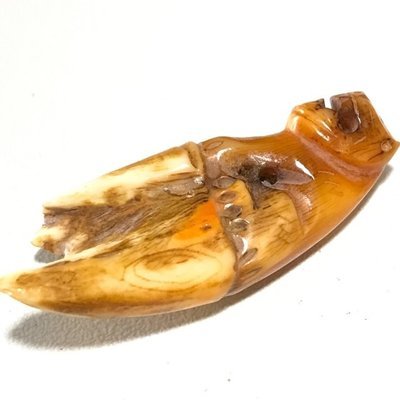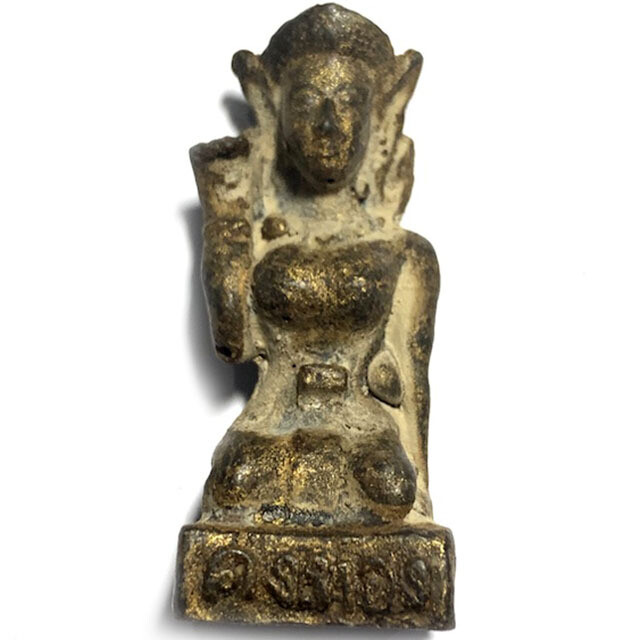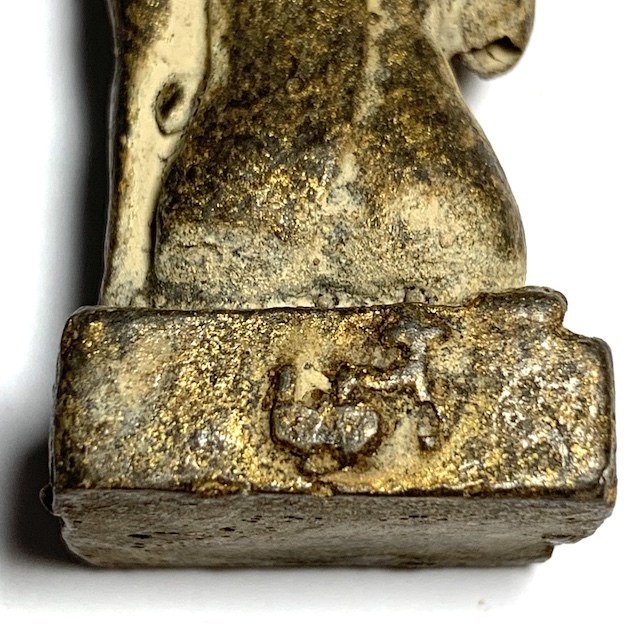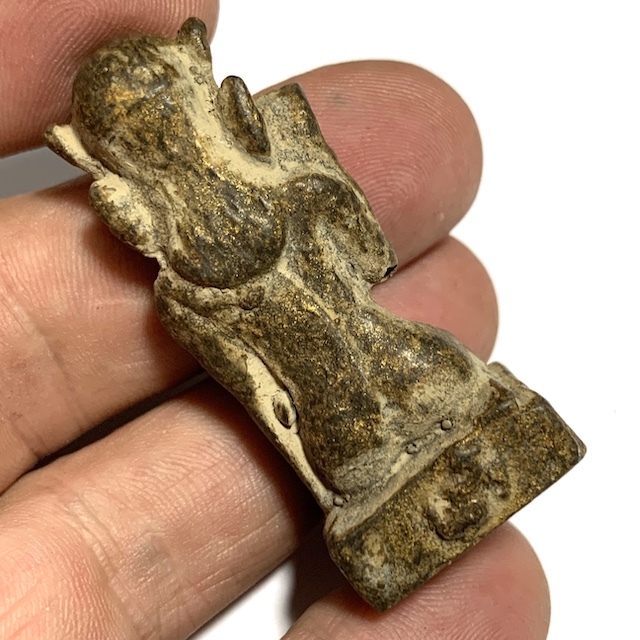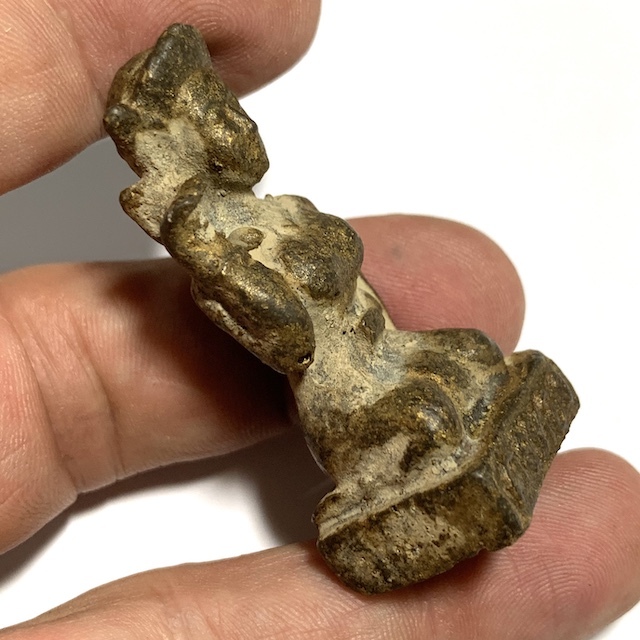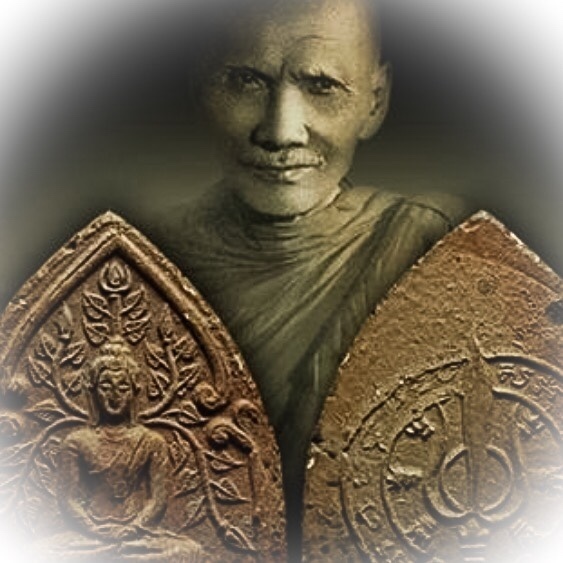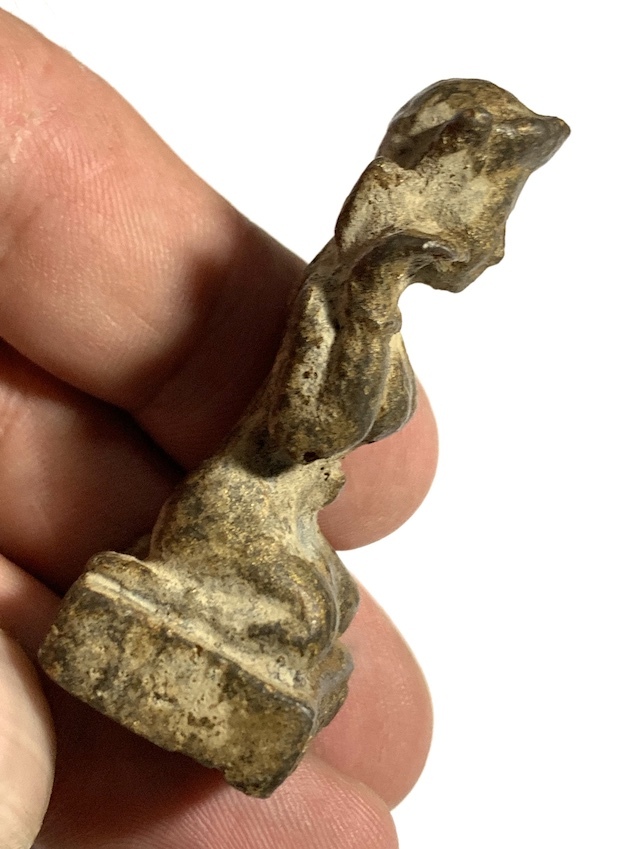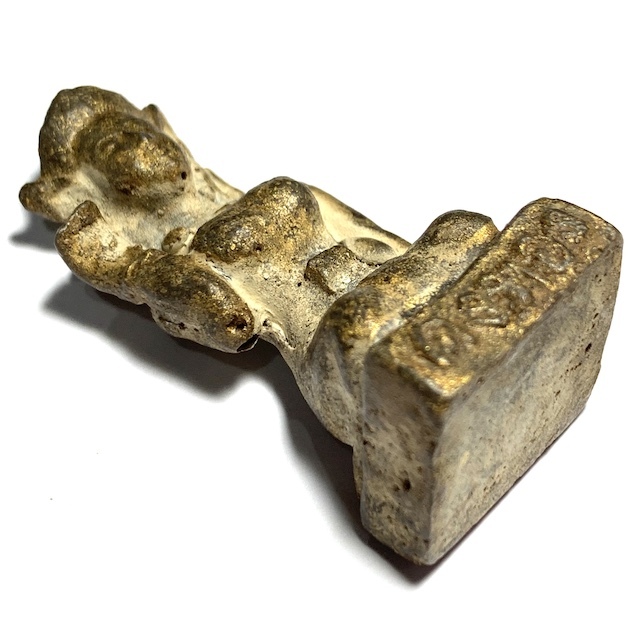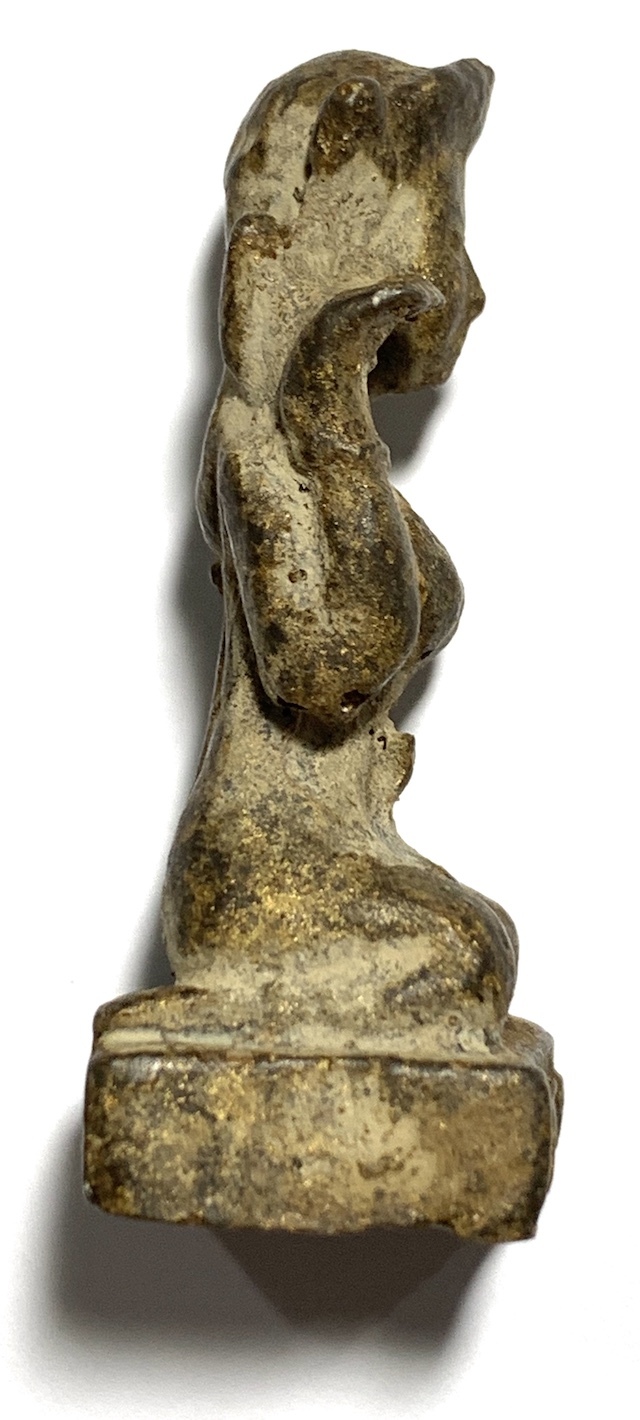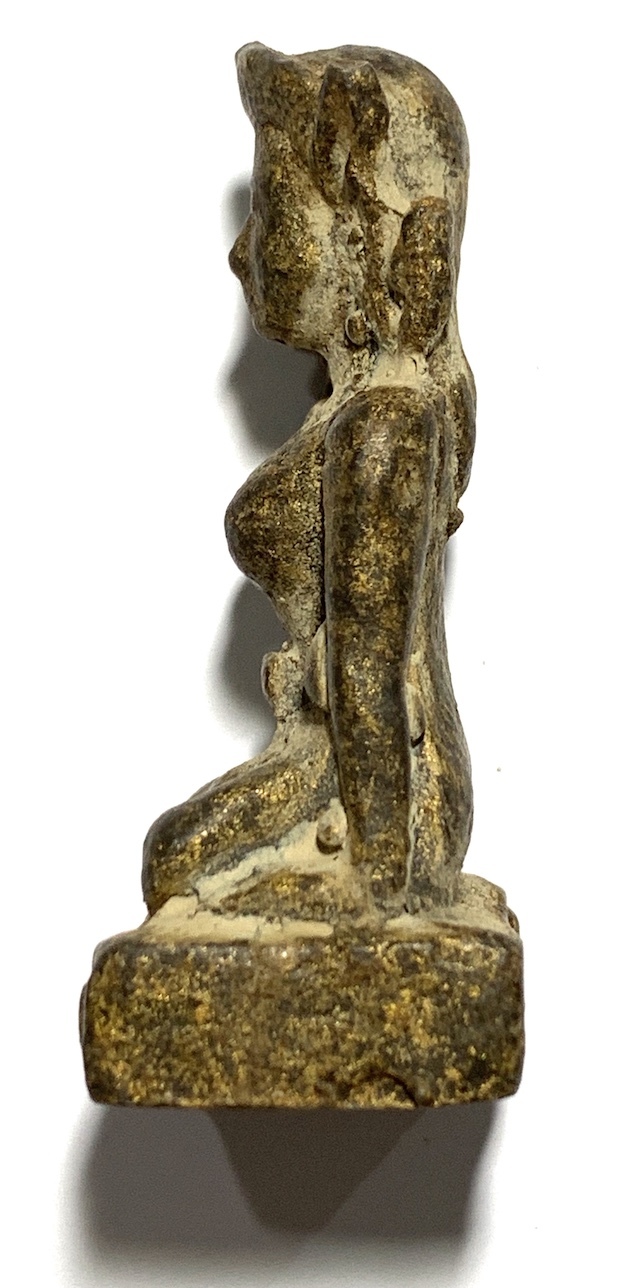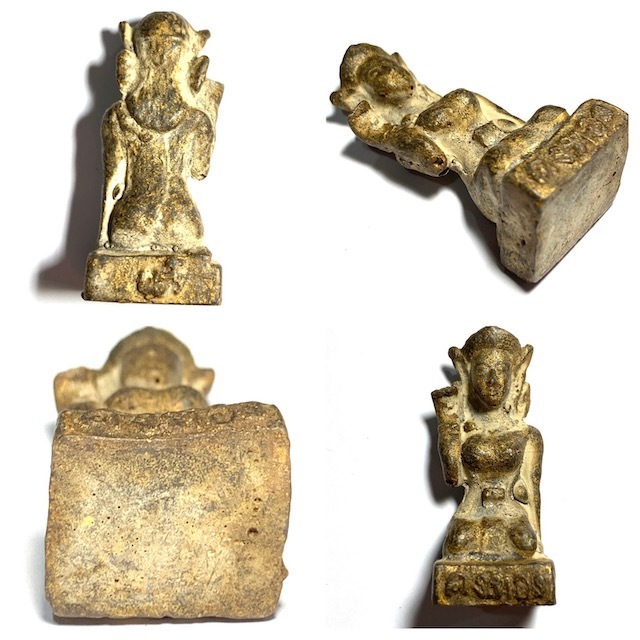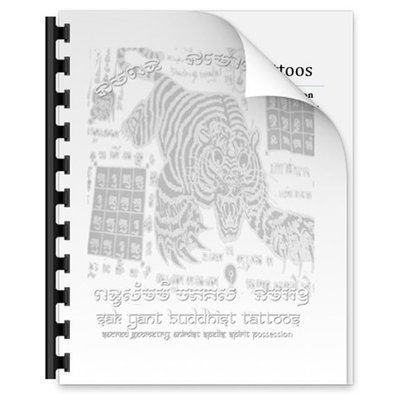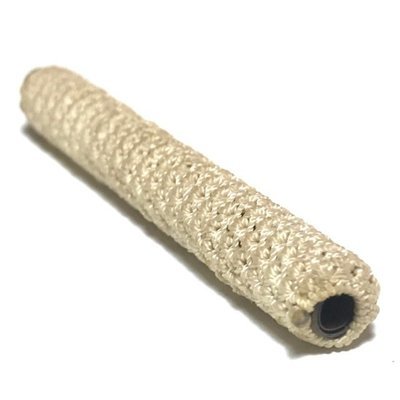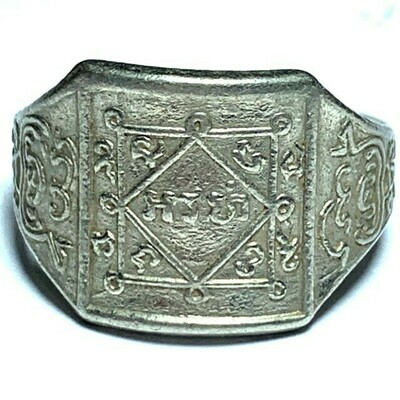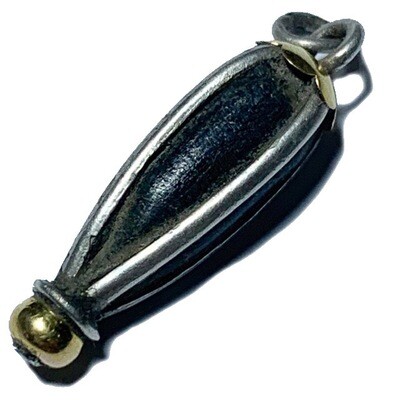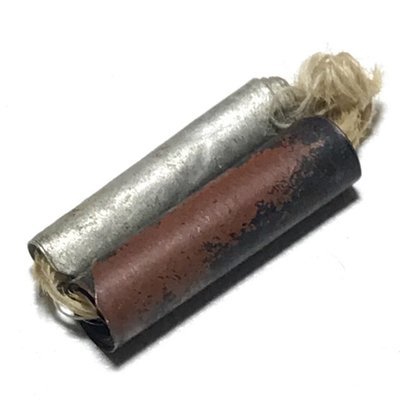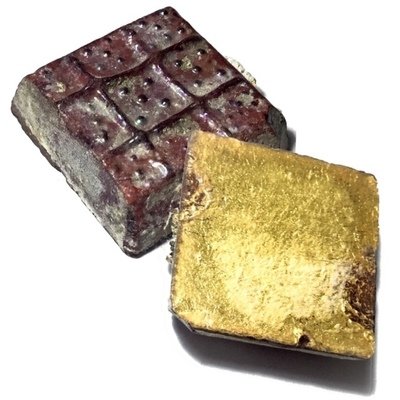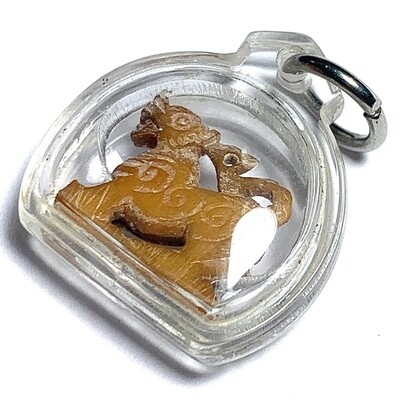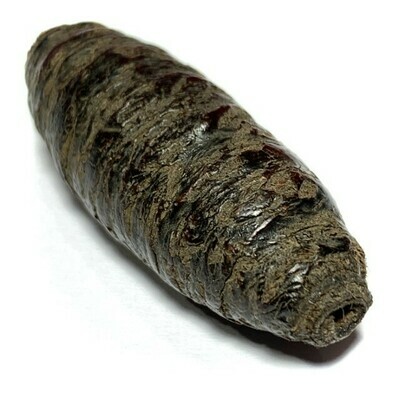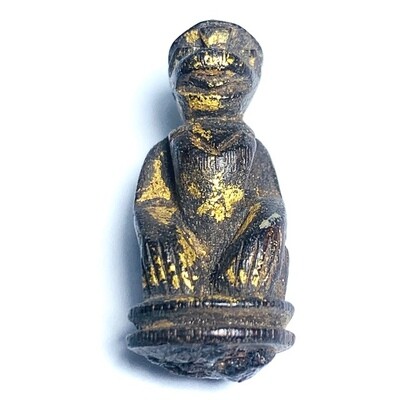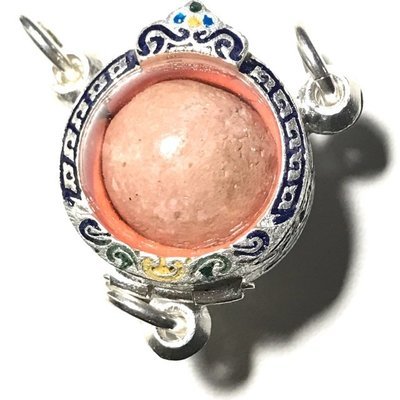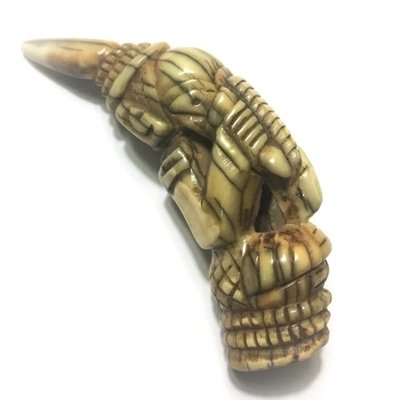A pristinely kept and extremely rare Rian Mangorn Koo Nuea Nava Loha Pim Pised Dtok Sorng Code Ma Wat Pha Nong Lom Run Sao Ha Maha Sethee 5th Lunar Saturday Blessing Ceremony Edition Guru Monk Coin, released in 2543 BE, to raise funds for the Kuti Songk Monks Huts and improve the facilities at the temple of Wat Pha Nong Lom.
This model of Rian Mangorn Koo twin dragons Monk Coin is a very rare Pim Pised (Niyom preferred) and differs from the majority of Rian Mangorn Koo Wat Pha Nong Lom Edition coins in Nava Loha, because of the double code MA stamp. Most coins of the Nava Loha series made for Wat Pha Nong Lom have only a single code Ma Stamp (on the Sangkati chest sash of the robe of Luang Phu), and only the Pim Pised special models received double code stamps. Only very few (unknown number) were distributed with double code stamp, making this not only a sacred, powerful master class amulet, but also a rare collectors piece.
The Rian Mangorn Koo of Luang Phu Hmun is, as are all of his amulets, known for the power of Jaroen Lap Wealth Increasement, and Lucky Fortunes, as well as for their Miraculous Protective Powers. Those born in the year of the dragon love to Bucha this amulet especially, for the obvious reason of the double dragon guardians.
For those with lower budgets, who seek power above collectability and rarity, we recommend to seek the Rian Mangorn Nuea Tong Daeng or Nava Loha single Code Ma, of the same edition, which carries a lower price than this special Nava Loha Pim Pised Gammagarn double code collectors edition model.
Pra Nang Kwak Nuea Din Jet Pha Cha Ratanakosin Era Style Bucha Statuette 2 Inches Luang Por Te Wat Sam Ngam
A very rare and exquisitely designed antique Sacred Pra Nang Kwak Supawadee Merchant's Daughter Loi Ongk Statuette in Ratanakosin Ayuttaya Era style of Buddhist Art, from the Great Olden Days Master of Kumarn Tong, Pla Tapian and Wicha Nang Kwak, Luang Por Te Kong Tong, deceased abbot of Wat Sam Ngam. The statuette is usable as a mini Bucha statue for altar placement, on the cash till in your place of business, on the car dashboard for travling salesperson, or even for wearing as a portable amulet.

The Muan Sarn Powders are coated with a deeply embedded long-time-passage affixed gold leaf flecks (Sai Rae Tong Kam), which is applied during pressing with Nam Man Prajao Taksin or Nam Man Nga Oil. The sacred clay reveals its immensely rich Powerful Prai powders Ingredients to the naked eye even without magnification.
The Sacred Muan Sarn Clay is made from Sacred Powders and Earths, including Din Jet Pha Cha seven earths from seven cemeteries, earths from seven busy ports, seven giant termite mounds,, seven salt licks, seven successful markets, and Prai oils for which Luang Por Te was so famous, rich in powerful magical ingredients.
The base of the statue has the words 'Kong Tong' embossed on front, and 'Te' on the rear, which is a common signature seen on amulets and statues of Luang Por Te.
Luang Por Te was a Great Sorceror Monk of the Second World War Era who had learned powerful Wicha Kumarn Tong from Khmer Sorcerors of the Lay Tradition, and was the direct Wicha inheritance Master apprenticeship holder of Luang Por Ta, of Wat Paniang Dtaek, and Luang Por Chaem, of Wat Ta Gong. He was present on many of the Greatest Blessing Ceremonies of amulets in Great temples around the country, almost always invited for his Powerful Wicha. He was regarded as the world's number one top master of his day for Wicha Kumarn Tong.
Nang Kwak is one of Thailands most commonly seen Deities. Her image is given offerings and prayed to, in order to increase wealth and business prosperity. She is a Deity revered by Merchants in both India and Thailand, by both Brahman, and Buddhists alike. Nang Gwak is the helper of all shop-owners and merchants. She is normally seen placed on a high shelf (normally a wooden or red and gold lintel, called ‘Hing’ in Thai) and offered “Nam Daeng” (a red syrupy drink, often used in Bucha offerings to Deities in Thai Buddhist practice).
Also, Incense, and flower garlands are offered to please Nang Kwak, and bring customers and make sales. Kata Nang Gwak is used when paying devotional merits to Nang Kwak, who is used in the place of business to increase the amount of customers and sales you may ingress. Nang Kwak is seen to be worshiped in most business establishments in Thailand, as Magical Yantra cloth or more often than not, as a statue, or statuette.
In the early years, Luang Por Te made mostly 'Krueang Rang' Talismanic Amulets and Occult Charms, such as the Takrut Hnaa Phaag Suea tiger forehead skin scroll spell, See Pheung, and the like. He also became famous for Nang Kwak statues, which were (and still are) immensely popular with merchants and market traders, and shop owners, for their Metta Maha Niyom Maha Sanaeh Maha Lap power to attract customers and admirers, and bring successful business.
But as he came to be abbot of Wat Sam Ngam, he saw there were many robbers and thieves in the province, and so began to make and distribute Kumarn Tong using the Khmer Wicha he has mastered under his Khmer Lersi Guru. He distributed his now so very world famous and legendary Kumarn Tong to the devotees to protect their households and shop stalls, and a miraculous change came to the life of the local folk, as the effect of the Kumarn Tong was excellent.
Robberies and Burglaries reduced to an almost unnoticeable level. But Luang Por Te did not only empower the Kumarn Tong for Protection; The powerful Metta Mahaniyom Maha Sanaeh Maha Lap Magic of the Kumarn Tong also brought the municipality and indeed the province of Nakorn Pathom to increasing prosperity as the local traders and market sellers experienced incredible increase in profits, customers, and even lucky fortunes with lottery.
Thus it began, that the legend of the Kumarn Tong Luang Por Te was begun. Although Luang Por Te was and continues to remain world famous for his powerful wicha Kumarn Tong, Luang Por also made a vast array of other amulets, almost all of which are popular and considered very powerful. He made many types of Takrut (especially famed for the Tiger Forehead Takrut), See Pheung and Nam Man Prai, Sacred Powder amulets, metal coins, occult charms, Pha Yant (Yantra Cloths), and varuious kinds of Bucha statues. His power of Kong Grapan Chadtri, Klaew Klaad, Maha Lap, Kaa Khaay, Maha Pokaap and Maha Amnaj, also enjoys legendary status and world wide fame.
LP Te would make amulets in various manners using different methods, mostly during the Second World War. Every single edition or type of amulet he made was the cause of miraculous events which have become legends that are still told of to this day.
He never really focused much on finding special artists or developing any kind of fine Buddhist art out of the amulet design, rather focused entirely on the empowerment and gave little importance, or at least second place, to the elegance of design or features of his own hand made amulets. However the 2505 BE Edition, and the Monk Coins which were designed by Qualified Artisans, reflect a very high standard of Artistry, and are Important works of Miniature Thai Buddhist Art. there are however a few editions where some very beautiful models were made, such as his edition of earthen baked clay Buddha Images.
His Kumarn Tong and Nang Kwak statues and other amulets, are worshipped by devotees from all continents on the planet, and the large number of people who claim to have had overturning success after making Bucha to his amulets is a further proof of the effectivity of his amulets and of his ability to empower them properly. He was intensely aiming for the highest concentration of Puttakun Power for people to have some portable form of protection to carry with them, and to make Bucha statues for their homes and business establishments. Luang Por Te presided over the temple of Wat Sam Ngam, for many years performing meritorious deeds for the folk of Nakorn Pathom, and was extremely beloved.
Luang Por Te passed away on the 25th December 2524 at the age of 80 years old, 6 months, 10 days. It was his 59th year of Ordination as a Bhikkhu. His remains are currently held on display for his Devotees to worship at the temple of Wat Sam Ngam.
Use the Traditional Thai Buddhist Method for Bucha;
1. Chant Maha Namasakara (3 Times)
2. Chant the Kata Nang Kwak
3. Chant Kata Aaraatanaa Pra Krueang (3 Times)
Kata Maha Namasakara
Namo Dtat-Sa Pakawa-Dto Araha-Dto Sam-Maa Sam-Put-Dtat-Sa
Namo Dtat-Sa Pakawa-Dto Araha-Dto Sam-Maa Sam-Put-Dtat-Sa
Namo Dtat-Sa Pakawa-Dto Araha-Dto Sam-Maa Sam-Put-Dtat-Sa
Trai Soranakom
Puttang Cheewidtang Yaawa Nipaanang Saranang Kajchaami
Tammang Cheewidtang Yaawa Nipaanang Saranang Kajchaami
Sangkang Cheewidtang Yaawa Nipaanang Saranang Kajchaami
Tudtiyambpi Puttang Cheewidtang Yaawa Nipaanang Saranang Kajchaami
Tudtiyambpi Tammang Cheewidtang Yaawa Nipaanang Saranang Kajchaami
Tudtiyambpi Sangkang Cheewidtang Yaawa Nipaanang Saranang Kajchaami
Dtadtiyambpi Puttang Cheewidtang Yaawa Nipaanang Saranang Kajchaami
Dtadtiyambpi Tammang Cheewidtang Yaawa Nipaanang Saranang Kajchaami
Dtadtiyambpi Sangkang Cheewidtang Yaawa Nipaanang Saranang Kajchaami
Kata Aaraatana Pra Krueang
Puttang Aaraatanaanang
Tammang Aaraatanaanang
Sangkang Aaraatanaanang
Puttang Prasittimae
Tammang Prasittimae
Sangkang Prasittimae
